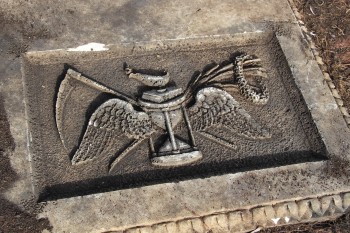Glossaries
| Term | Definition |
|---|---|
| oak leaves | Various meanings can be assigned to this. Oak was considered indestructible and was therefore a symbol of the imperishable. In ancient times, a laurel wreath of oak leaves was given to overcomers as a sign of imperishable honor. In the Netherlands during the Second World War it was a much used symbolism on funerary monuments for members and sympathizers of the NSB (a Dutch fascist and later Nazi political party). It is not known whether this specific application also occurs outside the Netherlands (in particular Suriname, the Caribbean islands and Indonesia). |
| oil lamp |
Oil lamp. Symbol of the eternal light, referring to eternity and immortality. It is the symbol of Christ who is the light of the world (John 8:12). |
| olive branch | The olive tree is a symbol of justice, peace and piety and God's care for His children. Judeo-Christian tradition has it that a dove announced the end of the flood with an olive branch in its beak. (Genesis 8:11). Ever since, the dove and the olive branch have been symbols of peace. In the 18th century it was customary to use olive branches together with palm branches in funeral wreaths as a sign of peace and fame. |
| owl | The owl is a mythological bird in many cultures around the world. As a nocturnal animal, the Celts and Germans considered a bird with special skills, with the Germans the eagle owl was even a burial gift. In Ancient Egypt, an owl hieroglyph represented death, and in the Ancient Greeks and Romans, the eagle owl was a bird of the underworld. The Little Owl is identified with Pallas Athena, the Greek goddess of wisdom. Owls were considered unclean animals in the Old Testament. For Christians, the owl symbolized the idea that the Jews did not choose Christ as the Light of the World, but lived in darkness. The owl is also often associated with death in Central American and African cultures, for example as a guardian of the 'dark house of the earth'. As a nocturnal animal, it is not surprising that the owl became the symbol of darkness. In the sixteenth century, the piercing scream of an owl encouraged an association with the devil. And according to superstition, a death soon followed when an owl scratched in the night. From the end of the fifteenth century, the owl stood for wisdom in Western art, a reference to classical Greek civilization. But the owl also continued to depict the night. The owl appeared as a symbol of death in nocturnal scenes and memento-mori scenes. Sometimes an owl is seen on funerary monuments in combination with books, a clear reference to wisdom. However, usually the use of the owl can mainly be seen as a symbol of the purified soul, the being that can see in the darkness. |



